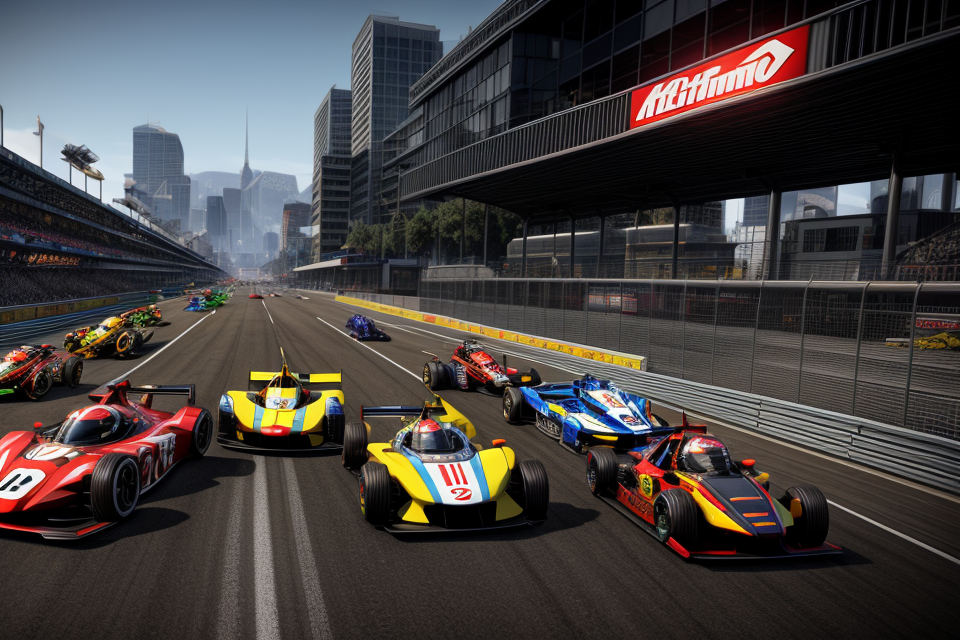Racing games have been a staple in the gaming industry for decades, with their thrilling, fast-paced gameplay captivating players of all ages. But when did racing games become popular? The origins of this iconic genre can be traced back to the early days of video games, with the first racing game being released in the late 1970s. Since then, the genre has evolved and grown, with new technologies and innovations driving its popularity to new heights. In this article, we’ll take a closer look at the evolution of racing games, exploring the key milestones and moments that have made this genre the beloved pastime it is today. So buckle up and get ready to rev your engines, as we explore the exciting history of racing games.
The Early Years: From Arcade Games to Home Consoles
The Rise of Arcade Racing Games
The origins of racing games can be traced back to the early days of video games, when simple graphics and limited technology meant that the games were relatively basic. However, as technology advanced and the gaming industry grew, so too did the complexity and sophistication of racing games.
One of the earliest examples of a racing game was “Sega Grand Prix,” which was released in 1974 and featured simple graphics and two-player racing. However, it was the release of “Pole Position” in 1982 that really kicked off the popularity of arcade racing games. This game featured better graphics and more realistic gameplay, and became a hit in arcades around the world.
As technology continued to improve, so too did the quality of arcade racing games. Games like “Out Run” and “Daytona USA” became huge hits in the late 1980s and early 1990s, and helped to cement the popularity of the genre. These games featured more realistic graphics, improved sound, and more varied tracks and gameplay than earlier racing games.
In addition to their popularity in arcades, racing games also began to appear on home consoles such as the Nintendo Entertainment System and Sega Genesis. Games like “Super Mario Kart” and “Sonic & All-Stars Racing Transformed” became hugely popular and helped to establish racing games as a staple of the gaming industry.
Overall, the rise of arcade racing games marked a significant turning point in the history of video games, and helped to establish the racing genre as one of the most popular and enduring in the industry.
The Transition to Home Consoles
The transition from arcade racing games to home console racing games was a significant turning point in the evolution of the genre. With the advent of home console gaming, racing games became more accessible to a wider audience, leading to a surge in popularity.
- The emergence of home console gaming: In the late 1970s and early 1980s, home console gaming began to gain popularity with the release of consoles such as the Atari 2600 and the Nintendo Entertainment System (NES). These consoles marked the beginning of a new era in gaming, allowing players to experience games in the comfort of their own homes.
- The impact of racing games on the growth of home console market: Racing games played a significant role in the growth of the home console market. With their realistic graphics and exciting gameplay, racing games quickly became a fan favorite among home console gamers. The success of early racing games such as “Indy 500” and “Sega Super Monaco GP” helped to establish the genre as a staple of home console gaming.
Additionally, the release of console-exclusive racing games such as “Mario Kart” and “Need for Speed” further solidified the genre’s popularity on home consoles. These games offered unique gameplay mechanics and innovative features that set them apart from their arcade counterparts, and helped to expand the appeal of racing games to a wider audience.
Overall, the transition to home consoles marked a significant turning point in the evolution of racing games. With their increased accessibility and innovative gameplay, home console racing games helped to establish the genre as a beloved staple of the gaming industry.
The 90s: A Decade of Technological Advancements and Classic Games
The Impact of 3D Graphics on Racing Games
The 1990s was a pivotal decade for the racing game genre, marked by significant technological advancements that transformed the way racing games were designed and played. One of the most notable advancements was the transition from 2D to 3D graphics, which revolutionized the gaming industry and had a profound impact on racing games in particular.
- The transition from 2D to 3D graphics
Before the 1990s, racing games were primarily 2D affairs, with sprites representing cars and tracks. While these games were fun and engaging, they lacked the sense of speed and realism that modern racing games are known for. With the advent of 3D graphics, however, racing games could finally showcase their full potential.
- How 3D graphics improved the realism and immersion of racing games
The move to 3D graphics allowed for a more immersive and realistic racing experience. Players could now see their cars and the track from multiple angles, giving them a better sense of speed and control. The inclusion of 3D environments also meant that tracks could be designed with more varied terrain, such as hairpin turns, jumps, and other obstacles.
In addition to enhancing the visual experience, 3D graphics also allowed for more advanced physics simulations. Cars could now be modeled with more realistic physics, taking into account factors such as weight, momentum, and friction. This made the driving experience more authentic and challenging, as players had to consider things like momentum and weight transfer when navigating turns and corners.
The impact of 3D graphics on racing games was immediate and profound. Games like “Nigel Mansell’s World Championship Racing” (1992) and “Sega Rally Championship” (1994) showcased the potential of 3D graphics and demonstrated how they could be used to create a more engaging and immersive racing experience. The 1990s saw a proliferation of 3D racing games, many of which are still considered classics today, including “Gran Turismo” (1997), “Need for Speed III: Hot Pursuit” (1999), and “Dirt Track Racing” (1998).
The transition to 3D graphics marked a significant turning point in the evolution of racing games, paving the way for more advanced and realistic gameplay mechanics. As the 1990s came to a close, the racing game genre had evolved significantly, thanks in large part to the advancements in 3D graphics technology.
The Creation of Iconic Racing Franchises
The Development of Franchises like Need for Speed and Gran Turismo
The 1990s were a pivotal time for the racing game genre, with several franchises emerging that would go on to become iconic within the industry. Two of the most influential franchises that were developed during this time were Electronic Arts’ Need for Speed and Polyphony Digital’s Gran Turismo.
The Influence of Need for Speed on the Racing Game Genre
Need for Speed was first released in 1994 and was developed by EA Canada. The game was revolutionary in its use of 3D graphics and its focus on high-speed racing. The game featured a variety of cars, including exotic sports cars and muscle cars, and allowed players to race against other cars in a variety of different tracks.
Need for Speed’s success was due in part to its innovative use of 3D graphics, which made the game feel more immersive and realistic than previous racing games. The game’s focus on high-speed racing also helped to set it apart from other racing games at the time, which often focused on simulation-style gameplay.
The Influence of Gran Turismo on the Racing Game Genre
Gran Turismo was first released in 1997 and was developed by Polyphony Digital. The game was highly innovative in its use of realistic car physics and its attention to detail in terms of the cars and tracks featured in the game. The game also featured a variety of different modes, including a career mode where players could progress through different racing leagues and a two-player mode where players could race against each other.
Gran Turismo’s realistic car physics were a major innovation in the racing game genre, as previous games had often simplified the physics of racing to make the game more accessible to players. The attention to detail in terms of the cars and tracks featured in the game also helped to make the game feel more immersive and realistic.
The Creation of Iconic Racing Franchises
The development of franchises like Need for Speed and Gran Turismo was instrumental in the popularization of racing games in the 1990s. These games helped to set the standard for the racing game genre and inspired other developers to create their own racing games.
The success of these franchises was due in part to their innovative use of 3D graphics and realistic car physics, which helped to make the games feel more immersive and realistic. The variety of different cars and tracks featured in the games also helped to make them more appealing to players.
Overall, the creation of iconic racing franchises like Need for Speed and Gran Turismo helped to establish the racing game genre as a popular and enduring form of entertainment. These franchises continue to be popular today and have inspired many other racing games to be developed in the years since their release.
The 2000s: Online Multiplayer and Realistic Simulations
The Emergence of Online Multiplayer
- The growth of online gaming and its impact on racing games
- The late 1990s saw the emergence of online gaming as a viable platform for gamers to connect and compete with one another.
- This new medium brought about a revolution in the gaming industry, as developers sought to create games that could be played over the internet.
- Racing games, with their emphasis on multiplayer competition, were particularly well-suited to this new medium.
- The rise of competitive online racing leagues and tournaments
- With the advent of online multiplayer, racing games became more accessible than ever before.
- Gamers could now compete against players from all over the world, rather than just those in their local area.
- This led to the rise of competitive online racing leagues and tournaments, which drew in thousands of players.
- These leagues and tournaments offered players the chance to test their skills against the best in the world, and provided a sense of community and camaraderie among players.
- As a result, online multiplayer became an integral part of the racing game experience, and has remained so to this day.
The Focus on Realism
As the 2000s dawned, racing games underwent a significant transformation in their approach to realism. The shift towards realistic simulations and physics marked a turning point in the genre’s history, with developers seeking to create a more immersive and authentic experience for players.
The primary drivers of this shift were advancements in technology and the growing demands of gamers for more sophisticated and engaging experiences. Here are some key factors that contributed to the focus on realism in racing games during this period:
- The rise of powerful gaming consoles: The release of consoles like the PlayStation 2 and Xbox allowed for greater processing power and improved graphics, enabling developers to create more detailed and realistic environments for racing games.
- The emergence of motion-capture technology: The development of advanced motion-capture technology allowed for the creation of more realistic animations and movements for in-game vehicles and characters. This helped to create a more believable and immersive racing experience for players.
- The influence of real-world racing: The popularity of real-world racing events, such as Formula One and NASCAR, inspired developers to create more accurate representations of these events in their games. This included replicating tracks, vehicles, and even the physics of racing.
- The growth of online multiplayer: The expansion of online multiplayer capabilities in the 2000s allowed for greater connectivity and competition among players. This encouraged developers to create more realistic racing environments that accurately reflected the dynamics of real-world racing.
Overall, the focus on realism in racing games during the 2000s represented a significant step forward in the genre’s evolution. By incorporating advanced technology and drawing inspiration from real-world racing, developers were able to create more engaging and immersive experiences for players, paving the way for the continued growth and popularity of racing games.
The Present Day: Virtual Reality and Esports
The Influence of Virtual Reality
With the advent of virtual reality (VR) technology, racing games have seen a significant shift in the way they are experienced by players. The integration of VR in racing games has brought about a new level of immersion and realism, allowing players to feel as if they are truly behind the wheel of a high-speed vehicle.
- The introduction of VR technology in racing games:
The first racing games to incorporate VR technology were introduced in the late 1990s and early 2000s. These games used rudimentary VR headsets that provided a basic sense of immersion, but the technology was still in its infancy and lacked the sophistication of modern VR systems. - The potential of VR to revolutionize the racing game experience:
Since then, VR technology has come a long way, and modern racing games have embraced the technology in a big way. With the advent of high-quality VR headsets and advanced motion controllers, players can now experience a level of immersion that was previously unimaginable. VR racing games provide players with a first-person perspective that puts them right in the driver’s seat, allowing them to feel the rush of speed and the thrill of competition in a way that traditional console or PC games simply cannot match.
Some of the most popular VR racing games include “Gran Turismo Sport” and “Project Cars 2”, both of which have been praised for their realistic physics engines and immersive VR experiences. Additionally, the rise of esports has led to the creation of professional racing game leagues and tournaments, where players can compete against each other in VR environments for large cash prizes.
In conclusion, the influence of VR technology on racing games has been profound, bringing a new level of immersion and realism to the genre. As VR technology continues to advance, it is likely that racing games will continue to evolve and push the boundaries of what is possible in gaming.
The Growth of Esports
Esports has experienced exponential growth in recent years, and this growth has had a significant impact on the racing game genre. Esports refers to organized competitions between players or teams in video games, often with prizes and spectators. In the case of racing games, esports has brought a new level of excitement and competition to the genre.
One of the key drivers of the growth of esports has been the rise of online gaming platforms and live streaming services. These platforms have made it easier than ever for players to compete against each other, and for fans to watch and follow their favorite players and teams.
In addition to the growth of online platforms, the emergence of professional racing game teams and leagues has played a significant role in the growth of esports. These teams and leagues provide a structured environment for players to compete at a high level, and they also offer lucrative prize pools and sponsorship deals.
As a result of the growth of esports, racing games have become a popular spectator sport, with millions of fans tuning in to watch live streams and tournaments. This has led to a surge in the popularity of racing games, as well as an increase in the number of players and teams competing at a high level.
Overall, the growth of esports has been a major factor in the continued popularity of racing games, and it is likely to play an even more significant role in the future of the genre.
The Future of Racing Games
The Continued Pursuit of Realism
As technology continues to advance, so too does the realism of racing games. Developers are constantly pushing the boundaries of what is possible, creating more immersive experiences for players.
One key area of focus is the ongoing development of advanced physics engines. These engines simulate the physical interactions between vehicles and the environment, allowing for more realistic handling and behavior. This attention to detail helps create a more authentic racing experience, with players able to feel the difference between various types of tracks and weather conditions.
In addition to advanced physics engines, there is also the potential for even more realistic racing simulations. For example, developers could incorporate real-world data on car performance and handling to create even more accurate representations of various vehicles. Additionally, incorporating live weather data and real-time track conditions could add an extra layer of realism to the gameplay.
As technology continues to evolve, it is likely that racing games will become even more realistic. This will be achieved through a combination of advancements in physics engines, improved data collection and analysis, and continued innovation in the gaming industry.
The Impact of Technological Advancements
The future of racing games is bright, as technological advancements continue to shape and define the genre. One of the most significant impacts of these advancements is the increasing influence of artificial intelligence (AI) and machine learning. These technologies have the potential to revolutionize the way racing games are designed and played, creating new opportunities for innovation and immersion.
One example of the impact of AI in racing games is the ability to create more realistic and dynamic opponents. By utilizing machine learning algorithms, game developers can create AI-controlled drivers that behave and react in a more realistic manner, making the racing experience more challenging and engaging. This can lead to more nuanced and strategic gameplay, as players must not only focus on beating their human opponents but also outmaneuvering and outwitting their AI opponents.
Another area where AI and machine learning are making an impact is in the creation of more realistic and detailed game environments. By using AI to generate procedural content, game developers can create vast and varied racing environments that feel more alive and immersive. This can lead to a more dynamic and engaging racing experience, as players must constantly adapt to changing track conditions and environmental factors.
Overall, the impact of technological advancements on racing games is significant and far-reaching. As these technologies continue to evolve and improve, it is likely that racing games will continue to innovate and push the boundaries of what is possible in the gaming world.
FAQs
1. When did racing games first appear?
Racing games have been around since the early days of video games. One of the earliest racing games was “Race” released in 1979 for the Atari 2600. However, it wasn’t until the late 1980s and early 1990s that racing games gained widespread popularity with the release of arcade games like “Out Run” and “Daytona USA” and home console games like “Super Mario Kart” and “Gran Turismo”.
2. What made racing games popular?
Racing games became popular for a number of reasons. One reason was the emergence of advanced graphics and sound capabilities in video game consoles, which allowed for more realistic and immersive gameplay. Additionally, the growth of the internet and online gaming made it easier for players to compete against each other, which added a new level of excitement and competition to the genre. Finally, the increasing popularity of car culture and motorsports also contributed to the popularity of racing games.
3. What are some of the most popular racing games?
There have been many popular racing games over the years, but some of the most iconic and beloved include “Mario Kart”, “Gran Turismo”, “Need for Speed”, “Forza Motorsport”, and “F1”. These games have been released on various platforms and have each contributed to the evolution of the racing game genre in their own way.
4. What are the current trends in racing games?
Current trends in racing games include the use of virtual reality (VR) technology to create more immersive experiences, the inclusion of real-world car brands and models, and the incorporation of esports elements such as tournaments and professional leagues. Additionally, many racing games are now available on mobile devices, making them more accessible to a wider audience.
5. How has the racing game genre evolved over time?
The racing game genre has evolved significantly over time. Early racing games were simple and focused on arcade-style gameplay, while later games became more realistic and simulation-based. With the advent of online gaming and esports, racing games have become more competitive and focused on multiplayer gameplay. Today’s racing games offer a wide range of experiences, from casual mobile games to immersive VR experiences.









